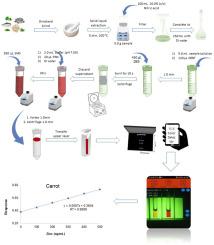Smartphone digital image colorimetry combined with deep eutectic vs supramolecular solvents liquid-liquid microextraction for cleanup and preconcentration of zinc in fish and vegetable samples
IF 5.8
2区 化学
Q2 CHEMISTRY, MULTIDISCIPLINARY
引用次数: 0
Abstract
Smartphone digital image colorimetry (SDIC) was combined with deep eutectic and supramolecular solvent liquid-liquid microextractions for the determination of zinc chelating with 1-(2-pyridylazo)-2-naphthol. A colored extract contained in a UV cuvette was placed in a locally designed colorimetric box, and the image was captured at optimum SDIC conditions. Sample cleanup and preconcentration were achieved with optimum complexation and extraction parameters. The suggested method has a limit of detection (LOD) between 3.46 and 19.43 ng mL−1, an enrichment factor (EF) between 10.9 and 15.5, and a linear dynamic range between 100 and 500 ng mL−1. The method shows good consistency, with a coefficient of determination (R2) between 0.9955 and 0.9998, and its precision, measured by the percentage relative standard deviation (%RSD), ranges from 1.4 to 4.2 for the same day and from 3.4 to 6.3 across different days. The accuracy of the method was also checked using a single-factor analysis of variance (ANOVA) by comparing its results with those from another independent UV–visible spectrophotometric technique, and both methods showed similar results (P > 0.05). A score of >0.62 on a scale of 0.0–1.0 for the analytical greenness when evaluated through the application of four green analytical tools indicates excellent analytical results. Additionally, promising greenness performance was also recorded with the AGREE tool when compared to other methods reported in the literature. The proposed method was employed for the determination of zinc in fish and vegetable samples, and the percentages of relative recoveries were recorded between 83.1 and 108.3 %.

智能手机数字图像比色法结合深度共晶与超分子溶剂液-液微萃取用于鱼和蔬菜样品中锌的清理和预富集
采用智能手机数字图像比色法(SDIC),结合深度共晶和超分子溶剂液液微萃取法,测定了1-(2-吡啶偶氮)-2-萘酚螯合锌的含量。将紫外比色管中的有色提取液置于当地设计的比色盒中,在最佳SDIC条件下捕获图像。在最佳络合和萃取参数下实现了样品的净化和富集。该方法的检出限(LOD)在3.46 ~ 19.43 ng mL−1之间,富集因子(EF)在10.9 ~ 15.5之间,线性动态范围在100 ~ 500 ng mL−1之间。方法一致性较好,决定系数(R2)在0.9955 ~ 0.9998之间,相对标准偏差(%RSD)测定的精密度在同一天范围为1.4 ~ 4.2,不同天范围为3.4 ~ 6.3。通过将该方法的结果与另一种独立紫外-可见分光光度法的结果进行比较,采用单因素方差分析(ANOVA)来检验该方法的准确性,两种方法的结果相似(P >;0.05)。通过应用四种绿色分析工具对分析绿色度进行评估时,在0.0-1.0的范围内得分为>;0.62表示分析结果优秀。此外,与文献中报道的其他方法相比,AGREE工具也记录了有希望的绿色性能。该方法可用于鱼类和蔬菜样品中锌的测定,相对回收率在83.1% ~ 108.3%之间。
本文章由计算机程序翻译,如有差异,请以英文原文为准。
求助全文
约1分钟内获得全文
求助全文
来源期刊

Sustainable Chemistry and Pharmacy
Environmental Science-Pollution
CiteScore
8.20
自引率
6.70%
发文量
274
审稿时长
37 days
期刊介绍:
Sustainable Chemistry and Pharmacy publishes research that is related to chemistry, pharmacy and sustainability science in a forward oriented manner. It provides a unique forum for the publication of innovative research on the intersection and overlap of chemistry and pharmacy on the one hand and sustainability on the other hand. This includes contributions related to increasing sustainability of chemistry and pharmaceutical science and industries itself as well as their products in relation to the contribution of these to sustainability itself. As an interdisciplinary and transdisciplinary journal it addresses all sustainability related issues along the life cycle of chemical and pharmaceutical products form resource related topics until the end of life of products. This includes not only natural science based approaches and issues but also from humanities, social science and economics as far as they are dealing with sustainability related to chemistry and pharmacy. Sustainable Chemistry and Pharmacy aims at bridging between disciplines as well as developing and developed countries.
 求助内容:
求助内容: 应助结果提醒方式:
应助结果提醒方式:


